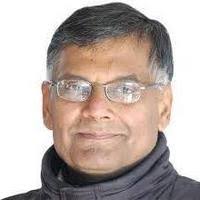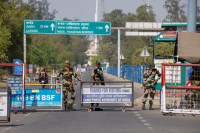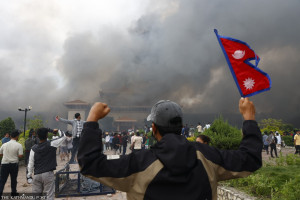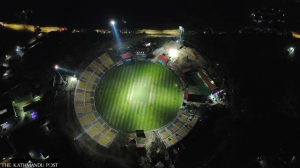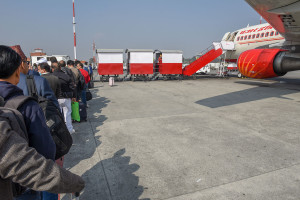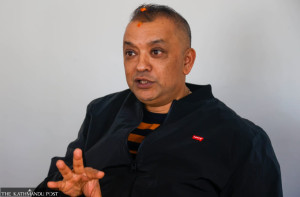Columns
Coping with the urban chaos in Kathmandu
Commuting challenges sap the energy of commoners trying to make a living in the metropolis.
CK Lal
For a Madheshi boy from the political periphery, social margins, economic backwaters and the cultural other of the dominant Bahun-Chhetri-Newar (BCN) mainstream, the capital city looked alien in the early 1970s. Lodged temporarily in a crumbling Rana mansion with a rusted iron gate, rotting wooden doors and a disintegrating boundary wall, he must have felt lost for the first few weeks in the unfamiliar surroundings.
The cushioning spring of an ancient bedstead in a huge room on the ground floor of the manor was still functional, but an in-house mouse appeared to have sharpened its teeth on the edges of the latex mattress. The lavatory in an outhouse often spilled over into a shallow ditch along the perimeter wall. Water trickled from a pipe, which had to be collected in metal buckets and stored in pots and pans. It made more sense to go to Sundhara for a wash than use the iron bucket and aluminium mug out in the wilderness that had once been a garden.
A few debilitated hippies routinely frequented the unguarded ground to rub the leaves of the cannabis plant that grew wild within the premises and then clean off the greenish deposit from their palms with blunt knives. Hashis was legit and was openly sold from every nook and corner of Jhochhen Tole that had come to be known as Freak Street. When it was outlawed in mid-1973, some policemen uprooted the plants.
Narrow streets of the old city around Basantpur were cleaned and paved for King Birendra’s coronation in 1975, but it took a German largesse to initiate a solid waste management system in the 1980s. Even though Kathmandu had got its first elected Mayor in 1947, the political culture of a city council responsible towards and answerable to the public had failed to take root. It was not difficult to see that the Nagar Panchayat was completely dysfunctional under the authoritarian rule of Shah kings and their Pancha flunkeys.
Municipal malfunctioning
Right up to the restoration of democracy in 1990, one of the main duties of every elected representative in local Panchayat was to muster huge crowds in support of the royal family. The birthday of King Birendra on Poush 14, the memorial day of his father on Poush 1, the day of tribute to his grandfather on Falgun 7 and the day of commemorating the founder of Shah dynasty on Poush 27 were celebrated according to Bikram Sambat calendar every year with pomp and show, as were the birthdays of his stepmother on Bhadra 4 and that of his wife on Kartik 22.
Since the municipal body lacked legislative authority, it had to rely upon the generosity of line ministries in Singha Durbar to execute routine tasks—an anomaly that continues to incapacitate local and provincial governments of republican Nepal. There were no guidelines for building houses that had begun to sprout in the rice paddies with little road access, no pipeline and wires hung on bamboo poles for connection to the electric grid.
Ancient cities grew around centres of religious, military, commercial or political power. Most modern cities are either planned or at least regulated. A few organic cities evolve naturally over time from their nucleus of a marketplace or a service centre for the hinterland. The ease of movement along navigable rivers or highways leads to anarchic urbanisation and ungovernable settlements. Unlike traditional, planned, regulated or even anarchic towns, the political economy of populist authoritarianism transforms old settlements such as Dhaka, Karachi or Kathmandu into chaotic cities.
In a little over half-a-century, Kathmandu has unrecognisably changed. The population has ballooned: If its significant floating population is considered, more than 5 million people reside inside the valley at any given time. Buildings have become taller, roads are wider, cars are more numerous, shopping malls dominate main streets and fancy restaurants dish out previously unheard-of fusion cuisine. The lure of mistaken modernity—a preference for consumerism over citizenship—has weakened the democratic urge for liberty, equality, fraternity and secularity to such an extent that the livelihood, education, health and transportation for the urban poor have failed to become the primary concerns of the metropolitan government.
The capital has emerged as the centre of human trafficking, with senior ministers being named in various scams. The institutionalisation of differential education and health services for the rich and the poor has been accepted without a murmur. The comfortable class celebrated when the-then Prime Minister Baburam Bhattarai implemented the narrowing of footpaths to make more space for the cars. The middle class applauded as Mayor Balendra Shah ordered the removal of street vendors without offering them an alternative. Meanwhile, the movement from point A to point B within the city has become a nightmare, which is a pity because the shortest distance from the city centre to the Ring Road is only about 5 kilometres.
Private transport
Despite dire warnings about the carrying capacity of a saucer-shaped valley and the natural limits to growth it imposes, people continue to flock to Kathmandu from everywhere in the country. The Melamchi water has somewhat lessened the stress, but sewers routinely overflow and rivers stink. The thick haze that envelopes the valley except during the monsoon has made the capital city unliveable. However, it’s the challenges of commuting that sap the energy of commoners trying to make a living in the metropolis.
After shifting his capital from Gorkha to Kathmandu in 1768, PN Shah envisaged Kathmandu as a natural fortress and began to tightly control entry and exit from the valley. The system persisted up until the fall of Ranarchy in 1951. For the victorious elite from the rugged mountains, the concept of public transport was unacceptable: How could the courtiers and commoners share space as equals in the same vehicle? The authoritarian Shah rulers followed the same principle. After the liberalisation, privatisation and globalisation wave of the 1990s, the floodgates opened for car ownership.
In the name of reducing oil import and controlling air pollution, the government recently began the policy of encouraging the import of electric vehicles (EVs) even though it knows that private cars play a marginal role in easing movement, increasing productivity or ensuring social justice. Thoroughfares are often chock-a-block with stalled cars during the day and parked vehicles at night with no end in sight. Available options, however, can be unpalatable for the comfortable class that dominates the public discourse.
It makes little sense to have differential duties for Internal Combustion Engine (ICE) cars and Electric Vehicles (EVs) as personal transport: It’s the public vehicles such as EV trucks, buses and even taxis that can be allowed some advantage. Singapore has successfully implemented Certificate of Entitlement (COE) and Vehicle Quota System (VQS) through open bidding to control private ownership of cars. The Chennai Unified Metropolitan Transport Authority (CUMTA) has introduced a policy that requires proof of off-street parking space for registering a vehicle. The government of Maharashtra is likely to make parking space mandatory for car buyers.
Without efficient public transport, it will be difficult to contain the urban chaos in Kathmandu. The will to implement a pedestrian-friendly transportation system is long overdue.




 16.12°C Kathmandu
16.12°C Kathmandu